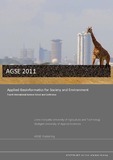Understanding the Spatial Prevalence of Cervical Cancer using GIS in Nairobi

View/
Date
2011Author
Karanja, Faith N
Wanyoro, AK
Type
BookLanguage
enMetadata
Show full item recordAbstract
The field of geoinformatics has shown tremendous growth not only in its technological advancement, but also in
its applications arena in the realms of society and environment. The use of technology in day-to-day life has
become ubiquitous. The growth of the application areas of geographical information systems, remote sensing,
photogrammetry, and related technologies has also kept pace. The advances of the geoinformatics technologies
as well as their applications have not only been felt in the developed countries, but also in the developing
countries too, especially in addressing environmental issues and the millennium development goals. The papers
presented in the Fourth Applied Geoinformatics for Society and Environment (AGSE) international conferencecum-
summer school elucidate this in the collection of research papers and workshops that span a wide range of
specialised areas under the umbrella of the year’s theme 'Geoinformation for a better world'.
This year’s motto resonates around the motto of the AGSE series of conferences: 'an interdisciplinary,
international forum for sharing knowledge about the application of geoinformatics with focus on application and
on developing countries'. AGSE has been doing this with yeoman spirit ever since its inception in 2008 through
the vision of Prof Franz-Josef Behr of the Stuttgart University of Applied Sciences, Germany. The first AGSE at
Trivandrum, in Kerala, India (AGSE 2008) signalled the tremendous enthusiasm the developed world holds for
geoinformatics, especially in the use of the Free and Open Source Software (FOSS) variety. Subsequent forums
have travelled to Stuttgart, Germany (AGSE 2009), Arequipa, Peru (AGSE2010) and now Nairobi, Kenya
(AGSE 2011), which shows the tremendous potential that geoinformatics has.
AGSE 2011 conference is special; it is being held for the first time in Africa, and particularly so in Nairobi,
Kenya, the city that hosts the headquarters of the United Nations Environmental Programme (UNEP). Besides
drawing a variety of papers from the international forum of the alumni of Stuttgart University of Applied
Sciences, a considerable contribution from other researchers has addressed the use geoinformatics in Africa, and
more so from the host country. The conference has attracted papers from more than 10 countries, spanning from
Malaysia to Chile, and from Germany all the way to Zambia. The scientific and application areas presented in
the papers are classed into eleven broad tracks or sub-themes namely: (1) General application papers, (2)
Internet-based and open source solutions, (3) Advances in GIScience and current developments, (4) Spatial data
infrastructures, (5) Environmental issues and sustainable development, (6) Natural resource management, and
monitoring (7) Disaster and risk management, (8) Geoinformatics in health, (9)Urban and regional planning,
(10) GIS in Education, and (11) Alumni experiences and business development. The importance of
geoinformatics in the environment cannot go unnoticed, as the applications of the technology and science
continue to draw a lot of interest. Examples of the application areas range from land use/land cover analysis for
sustainable tourism, land use dynamics in forest management systems, to pollution, among other environmental
oriented applications.
Publisher
Department of geospatial and space technology, university of Nairobi
